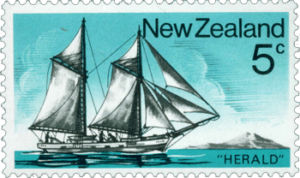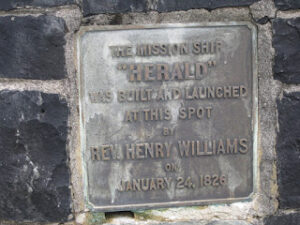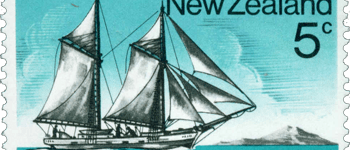1828: The Plundering of the Herald
May 6, 2022
By AHNZ

Today in New Zealand history, 6 May, 1828, the first ship ever built in this country came to a bad end. Herald was a Missionary-made ship launched on 24 January 1826 at the Paihia mission station. And, it was much needed.
Just as a young New Zealander achieves a developmental milestone when he has access to a car of his own the Church Missionary Society needed wheels. Or, sails, in this case. Mission Leader, Henry Williams, knew the young Mission needed independence. If they could grow their own food and trade more widely they would not be kept as pets by the Maoris as Williams’ predecessor Thomas Kendall had been. Nor would the Missionaries be held hostage to the provision of firearms to the Maoris in exchange for safety and supplies.
So, the brave Christians did what had never been done before (exception being the sealer boat Providence in 1793) and constructed a New Zealand ship.
Just as its end would be cursed by short-sighted natives, so was the beginning. As the launch date neared in 1826 thousands of Maoris gathered to be amazed by what Western technology could achieve out of New Zealand’s resources. The spectators were under the impression that a pay day had come for them because surely such a large ship would need muscle to haul it into the bay? When it was shown that vessel slid smoothly into the water via a slip thanks to gravity the natives’ jaws dropped dumbfounded. Amazement turned to anger as the Maoris realised their uninvited help would not be needed, some of them throwing their spears away trying to hit the ship!
“Having settled himself and his family at Paihia, Henry first attended to the secular side of the mission. He wanted to reduce the missionaries’ involvement with the trading captains of Kororāreka (Russell), to end their dependence on the Māori for supplies, and most of all he wanted to stop the musket trade in which the missionaries had been forced to engage. He quickly imposed regulations on the missionaries’ trading, but it was the completion in 1826, under Henry’s direction, of the 50 ton schooner Herald that really made the mission independent of local influences.” – Fisher (1990)
“Williams’s wife Marianne, who made this sketch, reported that 3,000–4,000 Māori gathered ‘partly’, she claimed, ‘in hope of payment’. Expecting that the Herald would be hauled into the water like a waka (canoe), the Māori people were reportedly amazed when the vessel slid smoothly into the water, and some threw spears at her. ” – McLean (2006)
“Schooner HERALD, Hokianga Bar, May 6th, 1828.— Wind fell when crossing the bar, and she was carried upon the rocks. The wreck was plundered by the Maoris, who did much wanton mischief . She was the first missionary schooner belonging to New Zealand.” – The Toll of the Sea, Otago Witness (1899); freepages.rootsweb.com/~nzbound
“Mr. Hobbs landed from the Kerikeri boat and communicated the painful intelligence that the Herald was on shore to the North of the Heads of Hokianga, but the crew safe, though severely treated by the Natives and much exposed to the weather.” – The Early Journals of Henry Williams (1961,) Early New Zealand Books, Auckland University

After just over 2 years of service, Herald came to a bad end at the Hokianga Bar on the other coast of the Island. At the crucial moment the wind was lost and the ship foundered. The crew had already been sitting ducks in bad sea for two days and now they had the ordeal of being dashed into the rocks overnight clinging to the rigging. Morning brought light and low tide so the survivors could make it to land but even now their troubles were only beginning.
As we have seen with the Harriet Affair, Maoris of this time period did not offer help to those in need but kicked them when they were down. A personality dominated by Concrete-thinking and Personality-thinking doesn’t attribute success and failure to control individuals have over their environment. Rather, it’s down to the gods or to luck that decides who does well in life. If the gods had marked ship’s Master Gilbert Mair and his crew for misfortune by their shipping mishap then that made them ripe for plunder.
The Missionary men were stripped naked, their ship plundered, the crew left in shock and suffering from hypothermia. Fortunately they survived and were rescued home by Henry Williams who wrote,..
“We walked along the coast till we came to our little vessel. No natives were in sight but the beach was covered with feet-marks and evidences of their abominable work on every side. The masts and spars were cut to pieces and the inside quite demolished, and not a vestige of rope to be seen–her deck had been set on fire in three places– the sight was distressing. Her hull did not appear to have suffered much, and yet we could not see any prospect of getting her off– part of the main keel was lying by her and some of her planks….called on Mr. S. Butler to thank him for his attention to Mr. Fairburn and the people. Many of the sails and blocks were among the natives here, and also much rope–they appeared to exult exceedingly in what had been done..” – ibid
The Honour Culture thing to do for Williams, the Maori thing, would have been to unleash bloody vengeance upon the looting tribe. As we have seen by his out-matching Chief Tohitapu, Williams was strong in Christian Dignity Culture. He had a Christian example to set for solving disputes and ending the cycle of violence peacefully and took the loss of the Herald as an opportunity to prove his integrity. ‘You are a strange tribe,’ said the Mission’s Maori friends to this. Williams fronted up to the vandals and remonstrated with them, ‘Declared the name of the Lord’ and then proceeded on the long journey back home to the Bay of Islands. The Hokianga Maoris were left to ponder the revelation that had been left at their feet that a future New Zealand could be different to the cruel and violent one they had known.
—
Image ref. The Schooner Herald, 5c stamp, NZ Post (1975,) philately.co.nz
Image ref. Launch monument, Historical Wanderings blog (2012)
Ref. Dictionary of New Zealand Biography, Robin Fisher (1990); Te Ara
Ref. ‘Shipbuilding – The wooden era’, Gavin McLean (2006); Te Ara
 Like Comment Share
Like Comment Share





